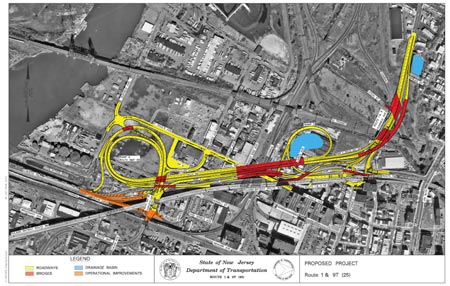Cultural Resources
In 1998 the Federal Highway Administration and the New Jersey Department of Transportation (NJDOT) initiated an investigation to identify cultural
resources within Jersey City that will be affected by the planned replacement of the Routes 1&9T St. Paul’s Avenue viaduct.

“Cultural resources” are historically or architecturally important structures such as buildings, bridges, cemeteries, or monuments; landscapes; or
archaeological sites. Federal laws protect these places and if they will be affected by a federally-funded project, measures must be taken to
“mitigate,” or lessen, the damage. If they cannot be avoided or preserved in place, then they are fully recorded, archaeological excavation is
performed to recover data, and new structures are designed in ways sensitive to the historic context.
One of the laws that cover this project is the National Historic Preservation Act, first passed in 1966. In compliance with
Section 106 of the Act, important historic resources are being preserved,
studied and recorded, or in other ways taken into account, in the design of the new roadways.
- The Routes 1&9 Historic District
Preservation Plan for the Route 1&9 Corridor (pdf 9m)
-
- 394-398 St. Paul’s Avenue
| On St. Paul’s Avenue across the railroad tracks from Covert Street, a nightclub occupies a structure that was built circa 1861. The
structure is heavily altered and it is difficult to spot the early house. On either side of it, where modern additions now stand, were two more
1860s houses, both demolished in the mid-20th
|
|
century. Even though the entire surface of the three former house lots has been paved, it is
considered likely that historic-period archaeological deposits are sealed beneath the rear yard.
Test trenches like those excavated in the Covert/Larch Historic District will be
dug once the business has moved out. If significant deposits are in fact present, full-scale archaeological excavations will proceed and the
artifacts recovered will be compared to those from the adjacent Covert/Larch neighborhood. |
- The Blakeslee Monument
The original Blakeslee Monument, standing at the intersection of Broadway, Wallis Avenue, and U.S. Routes 1&9, was dedicated on June
17, 1931. The monument marked Route 1 at the time, also known as the “Blakeslee Route.” It is a stone obelisk capped by a stone ball, and has a
bronze plaque with a portrait of George Blakeslee in relief.
|
| The monument honored George E. Blakeslee, an early advocate for road improvement who came to have a national reputation as the “Pioneer of the
Modern Highway” and the “Father of Good Roads.” He came to Jersey City in the 1890s, selling bicycles during the heyday of cycling, then turned to
automobiles, opening a Cadillac showroom on Kennedy Boulevard in the 1910s. In 1916, Blakeslee hired a lawyer to draft legislation calling for a
network of paved roads, resulting in the creation of the State Highway Commission and a seven-million-dollar bond issue for |
|
roadway construction. Blakeslee Route No. One was named in honor of his advocacy in 1930.
Source: “Blakeslee Monument” in Meredith Arms Bzdak and Douglas Petersen, Public Sculpture in New Jersey: Monuments to Collective
Identity, Rutgers University Press, page 109. |
- The Jersey City Water Works Pipeline (pdf 21.7m)
The Federal Highway Administration (FHWA) is
funding the Routes 1&9T/St. Paul’s Avenue Viaduct project and its cultural resources investigations.
The NJDOT oversees the contracted investigations. The Project Manager is Steven Hochman and Ihor Sypko is supervising the archaeological and other cultural resources research for the Department.
The prime consultant for design of the Routes 1&9T improvements is Hardesty and Hanover of Hoboken, NJ.
The RBA Group of Morristown, NJ is the consulting firm hired to conduct the cultural resources investigations.
There are files that are in Portable Document Format (PDF). You will need Adobe Acrobat Reader to view these files, which is available at our state Adobe Access page.
|


